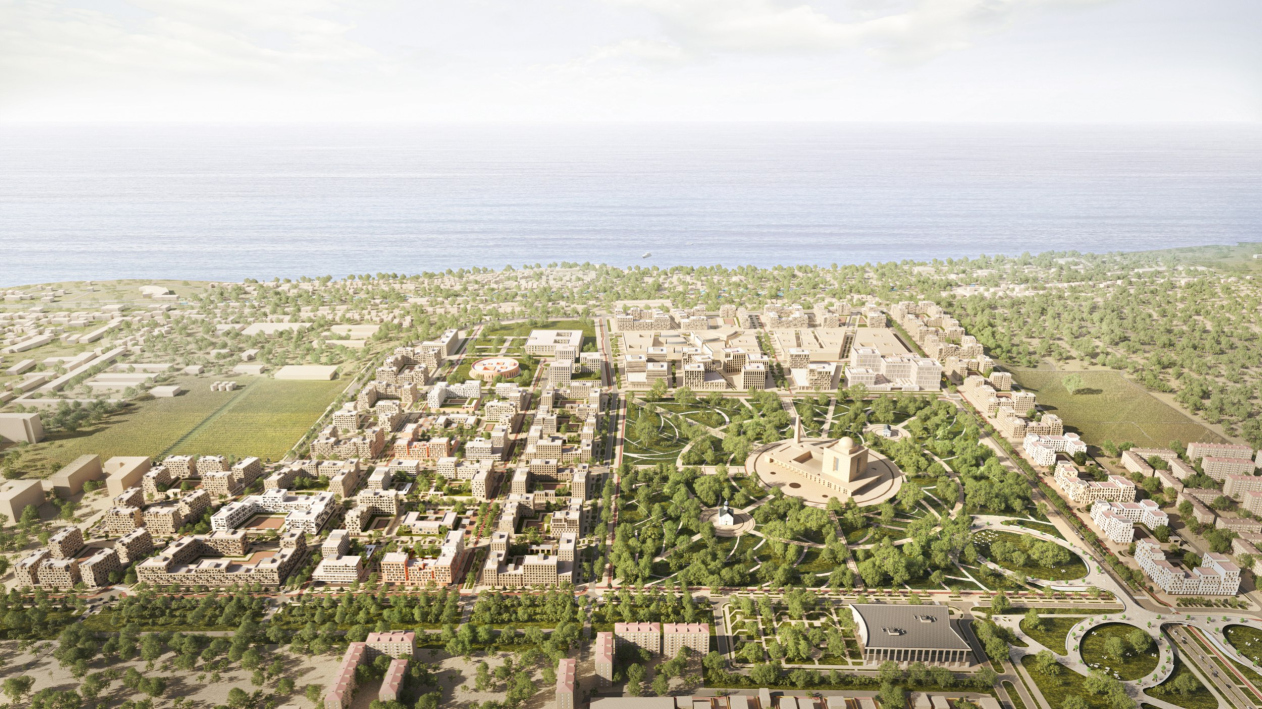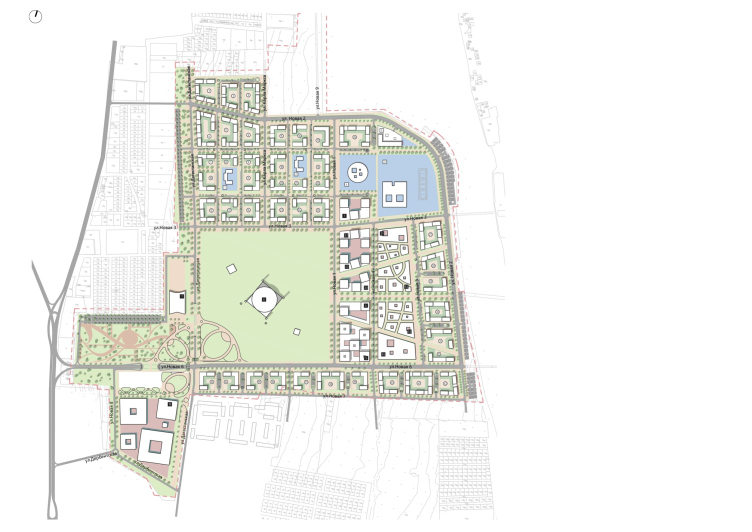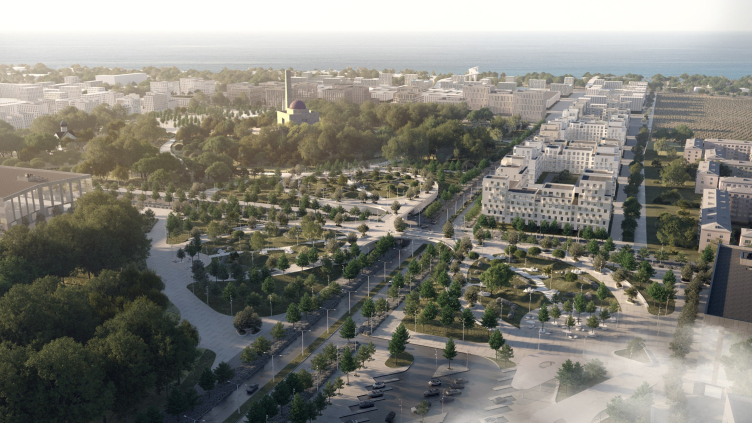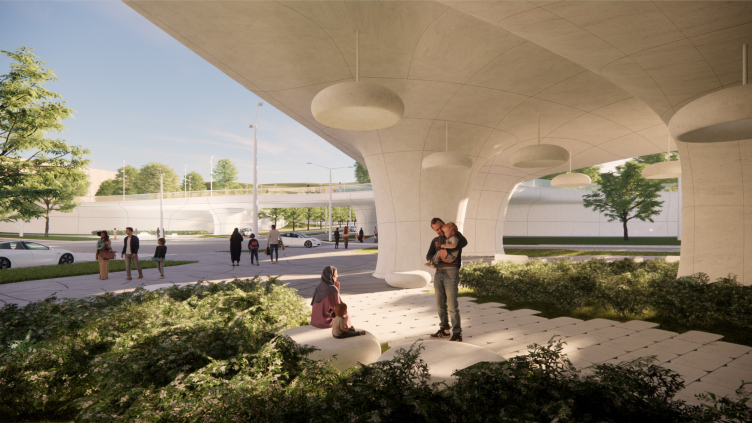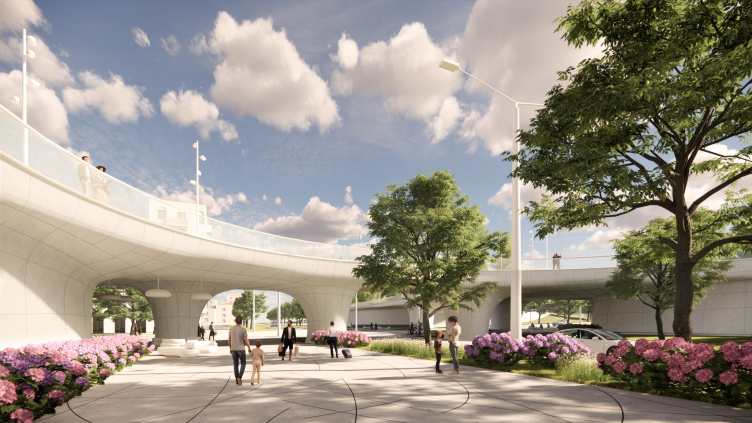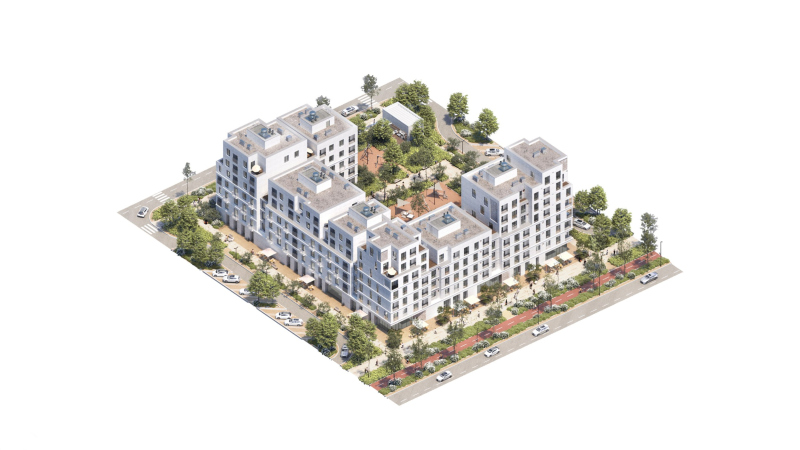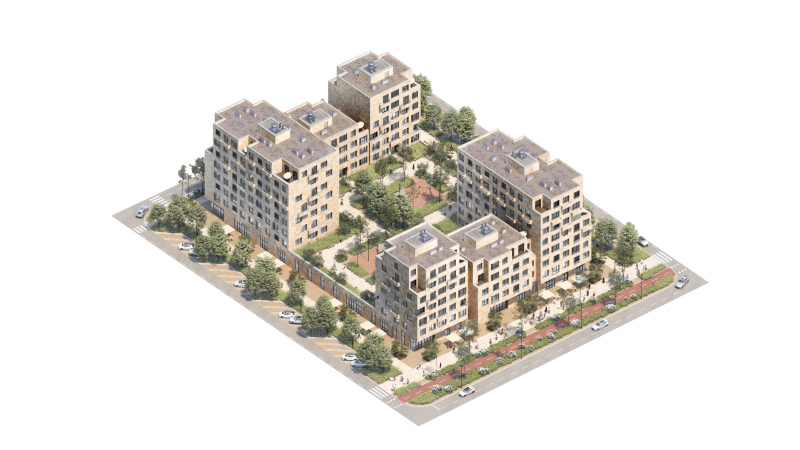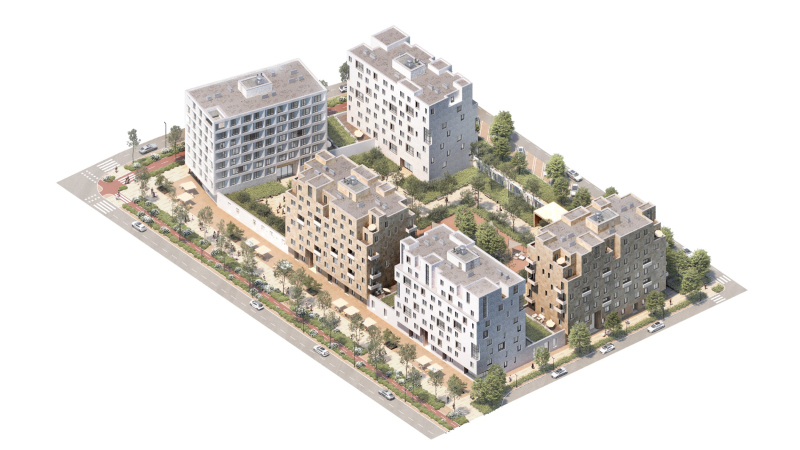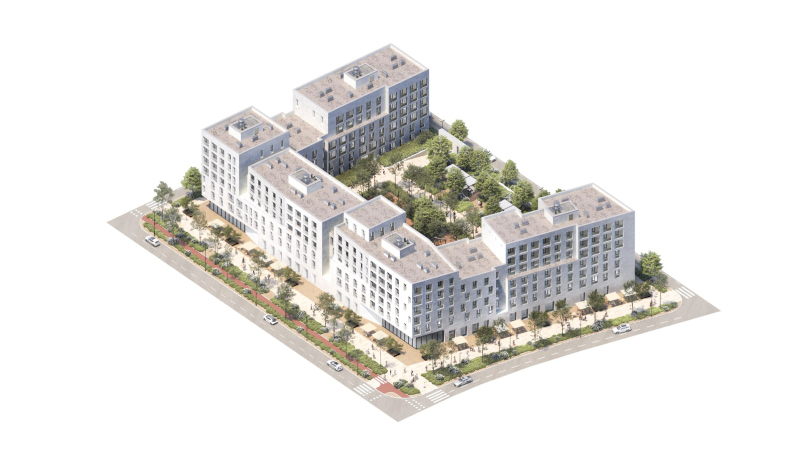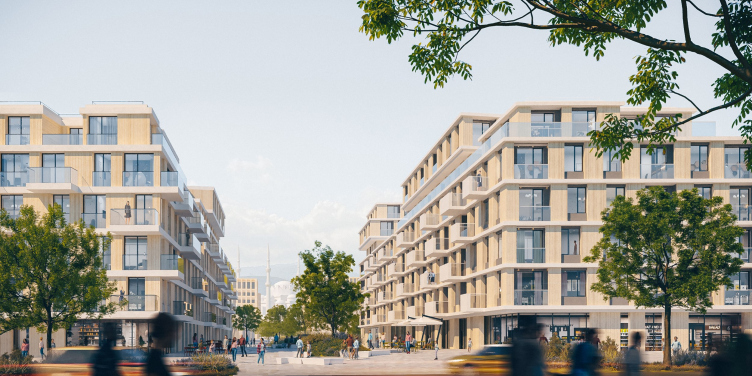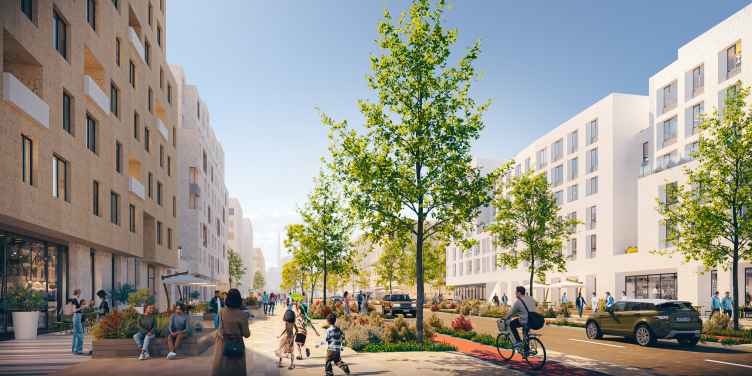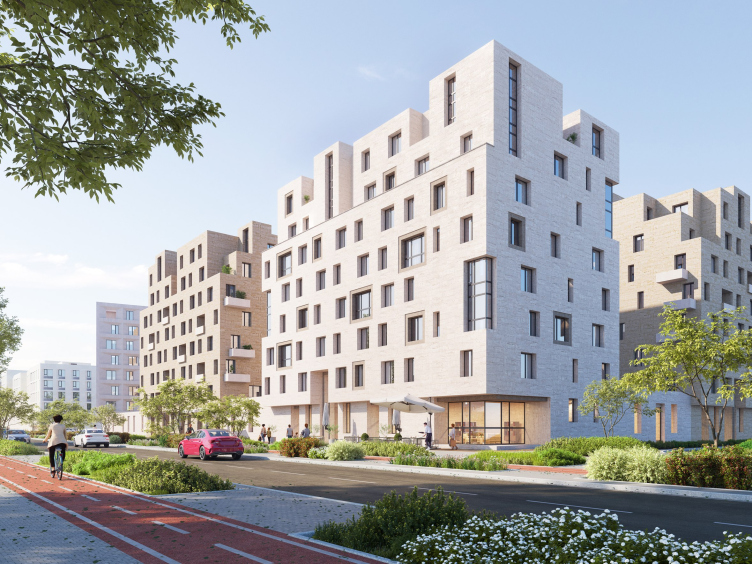Derbent is not only the oldest city in Russia, but also the first one to start implementing such a master plan. The competition for its development was held in 2019; currently, much of the project developed by the winning consortium has already been implemented: a section of the seaside boulevard has been improved, the ancient quarters of Magala have been tidied up, the “Tourist Mile” route has connected the tourist attractions, parks and public gardens have been opened, and a sports palace is under construction. There are still many projects ahead to turn the city into a sought-after resort, but already now the city is clearly attractive not only for tourists, but also for investors.
One of the activities of the master plan is the so-called New Derbent: a residential neighborhood in the southern part of the city that will occupy 160 hectares of former vineyards between the Caspian Sea and the mountain slopes.
The initiative to create such a district came from the city administration and the city’s chief architect Isa Magomedov, who was extremely involved in the transformation, so the program far exceeded the standard development one: in addition to housing and schools, there will be a spiritual center, a marriage palace, an educational cluster, and other projects, which together will represent a piece of exemplary modern Derbent. With this project, the city administration has streamlined the arrival of investors in the city: for the city center, they duly introduced height restrictions and façade regulations, and the developers were offered a free territory, which was further regulated by its own master plan, which defined the parameters of the development and its design code. This is quite an appropriate step, given the kind of high-rise neighborhoods that have begun to appear on the outskirts of Derbent in recent years.
The first to work with the land site were the foreign practices WATG and Tanmiya. Then OSA – with extensive experience in preparing similar projects – was involved in the work.
Three Centerpieces
From the very beginning, it was determined that the heart of the new district – both semantic and spatial – would be the Spiritual Center, for which a 36-hectare square land site, clearly visible from the Kavkaz highway, was allocated. Given the significance and scale of the project, a competition was held for it in 2021: the concept included a mosque named “Mother’s Tears” for 40,000 worshippers, an Orthodox church and a synagogue, as well as the improvement of the park with the creation of a library and a museum. None of the submitted competition projects fully satisfied the administration, and it is likely that another competition will be held in the future.
The “Southern” district
Copyright: © OSA
The mosque as the main object of the spiritual center becomes the point of reference for building the composition of the entire neighborhood, which corresponds to the classical approach to urban planning based on the centric system and the system of axes. The mosque determined the location of the new streets, as well as the hierarchy of neighborhoods: the closer to it, the more solemn and austere the facades are.
Two more public clusters are being built together with the mosque in a diagonal pattern. At the entrance to the new district from the “Kavkaz” highway, there is a Hospitality Center: here worshippers and tourists will be able to leave their cars, rent a hotel room, have a snack, and get the necessary information. Across the road from it, there is a marriage palace. The opposite corner includes educational institutions: a university building, a school, an educational center, and a medical center.
The “Southern” district
Copyright: © OSA
The connecting link between all three clusters and the entry point for visitors is a pedestrian bridge, which forms an extensive system of barrier-free promenades. The office held an internal competition to find the shape of this element.
The “Southern” district
Copyright: © OSA
The bridge is supposed to be spanning three artificial hills, so that its canvas smoothly rises and falls, opening up views of the mountains, the sea and the spiritual center. The second level increases pedestrian space and also provides shaded areas. When viewed from above, the curves of the aerial promenades resemble Arabic ligature. There is already a similar bridge in the center of Derbent, connecting the “Tourist Mile” with Nizami Park – it is invariably popular among citizens and tourists.
The “Southern” district
Copyright: © OSA
The “Southern” district
Copyright: © OSA
A Street With a Design Code
The rest of the space is filled by mid-rise residential areas and the business center. As was already mentioned, they are subordinated to a hierarchy, the determining role in which is played by proximity to the spiritual center. The architects emphasize the typology of each block with the help of plastique and decorative solutions stipulated in the design code. Another influential factor is the sunshine, which can be very hot indeed here: to keep the rooms from overheating, the architects varied the depth of the chamfers, the pattern of balconies and the height of sections. Terraces are found more as an exception in order to diversify the apartment range and form a more expressive silhouette: according to OCA, people in Russia do not use summer rooms very often, even in regions with a hot climate.
The southern residential areas, located along the main latitudinal street with the project name of Izobilnaya (“Plentiful”), overlook the garden of the Spiritual Center and welcome visitors, including motorcades of officials. Therefore, the facades are austere and grand, but at the same time authentic, faced with Derbent stone, and there are no balconies or loggias on the street side. The blocks stretch all the way to the border of the site, where the railroad runs, and the sea view opens up.
The “Southern” district
Copyright: © OSA
The “Southern” district
Copyright: © OSA
The most representative front of the development is the eastern one, formed by administration buildings and business centers. Compositions of cubic blocks, not resembling ordinary residential neighborhoods, enriched the overall silhouette of the construction. Behind them, there are a hotel, shopping centers and an open-air market, without which it is impossible to imagine any southern city.
The “Southern” district
Copyright: © OSA
The last line is composed of the seaside residential blocks, where residents have the opportunity to admire the sea views: there are more terraces, more balconies, and a larger glazing area than in the other areas. The entire eastern quarter is cut by three beams of streets, in the perspective of which you can see either the sea or the mosque looming against the mountains. Peter the Great, who once traveled to Derbent, would have appreciated this solution – the three beams definitely remind one of the “Neva Trident” converging at the Admiralty.
The “Southern” district
Copyright: © OSA
The “Southern” district
Copyright: © OSA
The northern areas also overlook the garden of the Spiritual Center, but gradually dissolve into the existing development. Here, houses are compactly grouped around kindergartens, forming semi- enclosed city blocks whose courtyards form a network of green pedestrian routes. In the finishing of facades, plaster is allowed; as you get further away from the mosque their plastique becomes less tense. It is from this part of the district that the implementation of the master plan began – the residential complex “Granatovy” is being built on the border with the existing development, which the architects of the master plan assess positively: the developer uses the set of techniques laid down by them, and the design code works.
Flexible Links
The street and road network takes into account the variety of possible scenarios in the new neighborhood. A transportation semicircle makes it possible to connect the new district to the already existing streets, and a regular block grid allows for variation of daily routes and flexible traffic diversion without compromising the comfort of residents – for example, in the case of Friday prayers, which attract many worshippers, or the visit of top officials to the administrative block, when traffic restrictions are unavoidable.
The master plan includes overpasses that will connect the three beams of the streets in the eastern city block with the coast. Currently, the access to the sea is blocked by the railroad bed – as in almost the entire city: getting to the water in Derbent is not so easy yet; however, it is obvious that this will change in time. Building a railway station platform near the new district is not yet planned.
***
It is enough to spend just one hour in Derbent to understand that its southern districts will become a new stage in its urban history. Currently, the city does not have the thought-out ensemble quality and transparent hierarchy of streets that the new master plan offers. At the same time, the new blocks do not look alien: they are rooted not only in Derbent’s stone, ornaments and massive volumes, but also in a relatively low density, small number of stories and diverse silhouette. There are new houses that do not aspire to be taller than the religious buildings, streets from which one can see the horizon, the sea and the mountains, and gardens under the windows – such an environment is organic to a city with a population of a few more than a hundred thousand people.
Simultaneously with modern urban planning solutions, the southern district brings a new lifestyle to Derbent. And this, perhaps, is the only thing that raises questions. After the master plan began to be implemented, the cost per square meter of housing in the city has increased dramatically, while the income of residents has largely remained at the same level, pretty low. It is not clear who will populate the new residential areas in this case – the residents of Derbent, or still more affluent residents of the capitals, who will have a new place for wintering and an interesting option for investment.

